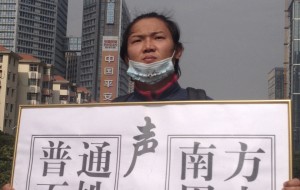Censorship and commercial pressures have driven the once-revered Southern Weekly to the margins.
BY MARIA REPNIKOVA, JANUARY 29, 2015
 Behind the Fall of China’s Greatest Newspaper
Behind the Fall of China’s Greatest Newspaper
In early January 2013, hundreds of protesters gathered in the southern Chinese city of Guangzhou in support of one of the country’s most influential liberal newspapers, Nanfang Zhoumo, or Southern Weekly, in a rare standoff against local propaganda officials. The Weekly, established in 1984 and claiming a present-day circulation of over 1.7 million, had long been regarded as a model of watchdog journalism. But under the thumb of then-new, conservative chief provincial censor, Tuo Zhen, the paper’s scheduled annual 2013 New Year editorial advocating constitutional reform had been secretly scrapped and replaced with a different version praising the Communist Party. Some Weekly journalists, angered at the meddling with the popular editorial, which since 1999 had set forth a vision for social change the editors hoped to see in the year ahead, openly demanded an investigation. Following days of public protests in support of the journalists, Guangzhou authorities reached a compromise with the paper. In an internal announcement, officials promised to “improve their methods of media management” if the paper would publish the next issue as planned.
Instead, over the past two years, the Weekly has continued to lose its erstwhile status. Journalists’ hopes that a collaborative attitude towards authorities could buy more room for solid reporting in the wake of protests have not seemed to pay off.Journalists’ hopes that a collaborative attitude towards authorities could buy more room for solid reporting in the wake of protests have not seemed to pay off. Tuo has remained in charge, and according to over ten staff reporters who currently work at the Weekly, tight censorship has persisted. As a result, the Weekly appears to be losing its luster in the eyes of Chinese literati. A number of media scholars, journalists, and Chinese officials alike observed that they now take the publication less seriously. “I no longer read the Weekly,” said a former high-ranking official speaking on background in March 2014. In January 2015, an expert in Chinese media who did not wish to be named said she had not read the Weekly directly in years, only looking at Weekly articles when friends posted them on social media.
Economic pressures have accompanied the political pressures facing the Weekly, at which one of this article’s authors worked from July 2010 to July 2013 before quitting to pursue graduate study in the United States. Since October 2014, the price of the paper has almost doubled from about $.50 to about $.80, while the number of articles has shrunk, suggesting difficulty in garnering readership and advertising revenue. In a November 2014 article for Southern Media Studies, a media-studies journal, Wang Wei, the current editor-in-chief of the Weekly, wrote that both revenue and profit declined in 2013 compared to 2012 (full-year 2014 statistics are not yet available.) As its reputation for a source of popular exposés began to fade, so, apparently, has its appeal to advertisers.
The Weekly once stood among the pioneers of serious investigative journalism in China. Since the 1990s, the Weekly had shown how engaging with social issues ignored by most other media – while staying away from authorities’ red lines – could make a publication commercially successful while allowing it to withstand the vicissitudes of Chinese politics. Its stories, which often channeled the frequently overlooked perspectives of disadvantaged groups, such as migrants, protesters, and government petitioners, drew a wide readership that included government authorities and the general public. Weekly reports like a May 2008 investigation into school collapses during the 2008 Sichuan earthquake, and the May 2010 undercover look into labor conditions at Foxconn factories, drove the national conversation.
For detail please visit here
